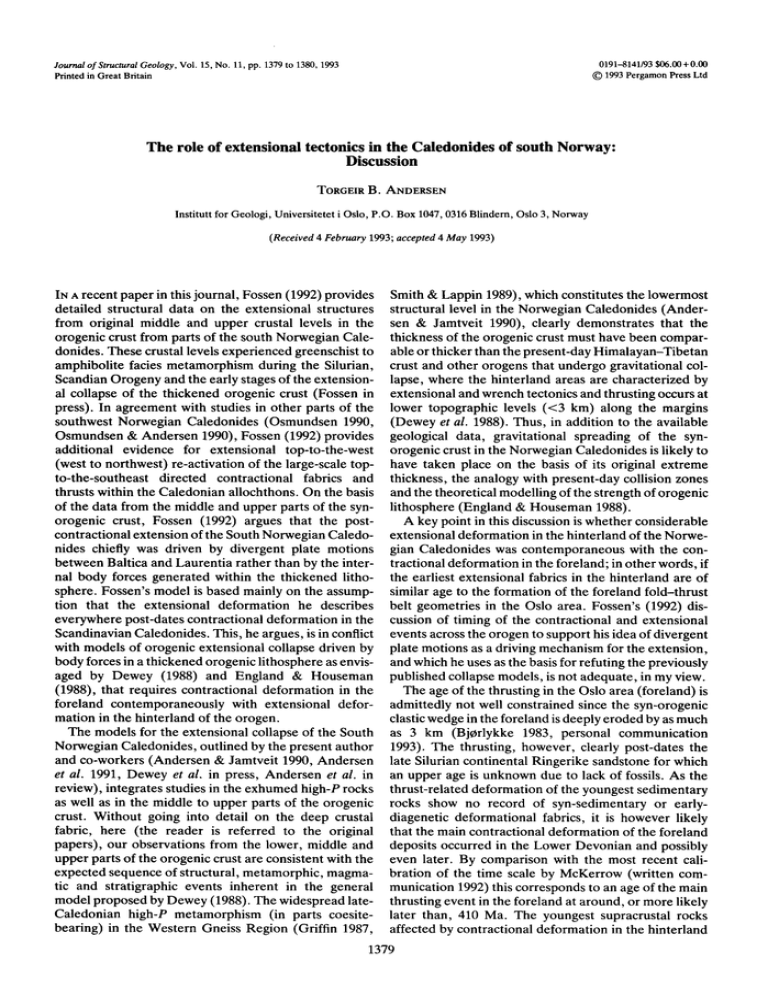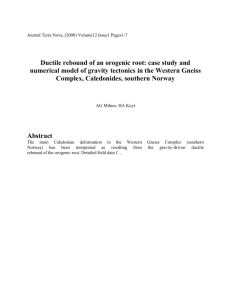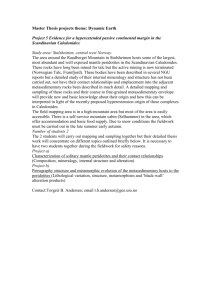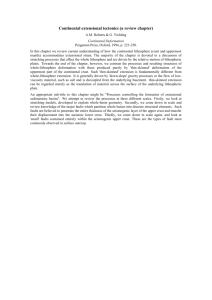Journal of Structural Geology,
advertisement

Journalof Structural Geology, Vol. 15, No. 11, pp. 1379 to 1380, 1993 0191-8141/93 $06.00+0.00 © 1993 Pergamon Press Ltd Printed in Great Britain The role of extensional tectonics in the Caledonides of south Norway: Discussion TORGEIRB. ANDERSEN Institutt for Geologi, Universitetet i Osio, P.O. Box 1047, 0316 Blindern, Oslo 3, Norway (Received 4 February 1993; accepted 4 May 1993) IN A recent paper in this journal, Fossen (1992) provides detailed structural data on the extensional structures from original middle and upper crustal levels in the orogenic crust from parts of the south Norwegian Caledonides. These crustal levels experienced greenschist to amphibolite facies metamorphism during the Silurian, Scandian Orogeny and the early stages of the extensional collapse of the thickened orogenic crust (Fossen in press). In agreement with studies in other parts of the southwest Norwegian Caledonides (Osmundsen 1990, Osmundsen & Andersen 1990), Fossen (1992) provides additional evidence for extensional top-to-the-west (west to northwest) re-activation of the large-scale topto-the-southeast directed contractional fabrics and thrusts within the Caledonian allochthons. On the basis of the data from the middle and upper parts of the synorogenic crust, Fossen (1992) argues that the postcontractional extension of the South Norwegian Caledonides chiefly was driven by divergent plate motions between Baltica and Laurentia rather than by the internal body forces generated within the thickened lithosphere. Fossen's model is based mainly on the assumption that the extensional deformation he describes everywhere post-dates contractional deformation in the Scandinavian Caledonides. This, he argues, is in conflict with models of orogenic extensional collapse driven by body forces in a thickened orogenic lithosphere as envisaged by Dewey (1988) and England & Houseman (1988), that requires contractional deformation in the foreland contemporaneously with extensional deformation in the hinterland of the orogen. The models for the extensional collapse of the South Norwegian Caledonides, outlined by the present author and co-workers (Andersen & Jamtveit 1990, Andersen et al. 1991, Dewey et al. in press, Andersen et al. in review), integrates studies in the exhumed high-P rocks as well as in the middle to upper parts of the orogenic crust. Without going into detail on the deep crustal fabric, here (the reader is referred to the original papers), our observations from the lower, middle and upper parts of the orogenic crust are consistent with the expected sequence of structural, metamorphic, magmatic and stratigraphic events inherent in the general model proposed by Dewey (1988). The widespread lateCaledonian high-P metamorphism (in parts coesitebearing) in the Western Gneiss Region (Griffin 1987, Smith & Lappin 1989), which constitutes the lowermost structural level in the Norwegian Caledonides (Andersen & Jamtveit 1990), clearly demonstrates that the thickness of the orogenic crust must have been comparable or thicker than the present-day Himalayan-Tibetan crust and other orogens that undergo gravitational collapse, where the hinterland areas are characterized by extensional and wrench tectonics and thrusting occurs at lower topographic levels (<3 km) along the margins (Dewey et al. 1988). Thus, in addition to the available geological data, gravitational spreading of the synorogenic crust in the Norwegian Caledonides is likely to have taken place on the basis of its original extreme thickness, the analogy with present-day collision zones and the theoretical modelling of the strength of orogenic lithosphere (England & Houseman 1988). A key point in this discussion is whether considerable extensional deformation in the hinterland of the Norwegian Caledonides was contemporaneous with the contractional deformation in the foreland; in other words, if the earliest extensional fabrics in the hinterland are of similar age to the formation of the foreland fold-thrust belt geometries in the Oslo area. Fossen's (1992) discussion of timing of the contractional and extensional events across the orogen to support his idea of divergent plate motions as a driving mechanism for the extension, and which he uses as the basis for refuting the previously published collapse models, is not adequate, in my view. The age of the thrusting in the Oslo area (foreland) is admittedly not well constrained since the syn-orogenic clastic wedge in the foreland is deeply eroded by as much as 3 km (Bj0rlykke 1983, personal communication 1993). The thrusting, however, clearly post-dates the late Silurian continental Ringerike sandstone for which an upper age is unknown due to lack of fossils. As the thrust-related deformation of the youngest sedimentary rocks show no record of syn-sedimentary or earlydiagenetic deformational fabrics, it is however likely that the main contractional deformation of the foreland deposits occurred in the Lower Devonian and possibly even later. By comparison with the most recent calibration of the time scale by McKerrow (written communication 1992) this corresponds to an age of the main thrusting event in the foreland at around, or more likely later than, 410 Ma. The youngest supracrustal rocks affected by contractional deformation in the hinterland 1379 1380 T . B . ANDERSEN are of Llandoverian or possibly Wenlockian age (Andersen et al. 1990), corresponding to 430--425 Ma on the same time scale. At this time the deposition in the foreland was still characterized by carbonates. The Devonian sedimentary rocks in the hanging wall of the extensional detachments in the Sogn-Sunnfjord region of western Norway contain Lower (?) to Middle Devonian (base Eifelian at 387 Ma, time scale after McKerrow written communication 1992) flora and fauna at high stratigraphic levels in the Kvamshesten and Hornelen basins. Detailed structural studies (Osmundsen 1990, Osmundsen & Andersen 1992, in revision, Hartz et al. in press) adjacent to these basins shows that the principal extensional unroofing of the Caledonian nappes that comprise the basement of the Devonian sediments occurred prior the deposition of these basins. The top-to-the-west extensional structures that are unconformably overlain by the Devonian red beds, were initially formed at the same metamorphic conditions as the latest contractional (top-to-the-east) structures. The extensional structures became increasingly semi-ductile to brittle prior to the deposition of the Old Red sediments, and most of the upper-plate extension that was rooted in the large-scale extensional detachments had terminated prior to the deposition of the Devonian sediments. Thus the Silurian (top-southeast) thrusting was immediately succeeded by extension (topwest) which unroofed the greenschist to amphibolite facies basement of the Devonian rocks over a period of approximately 25-30 Ma in the late Silurian-early Devonian. This suggests that the extensional unroofing in the hinterland at least partly was contemporaneous with deposition of the red beds and the subsequent thrusting of the rocks in the foreland. Furthermore, the basal 'Old R e d ' facies in the hanging-wall of the MOre-Tr0ndelag fault zone ( M T F Z ) , contain a fauna that apparently straddles the Siluro-Devonian boundary (Reusch 1914). These deposits are considerably older than the Devonian rocks discussed above, and of comparable age as the Ringerike sandstone in the Oslo area. Consequently these rocks in the hinterland are older than the thrusting in the foreland (Oslo area). Both the sedimentary facies and the structural studies shows that the deposition of the 'Old R e d ' along the M T F Z is related to extensional tectonics during the orogenic collapse (B0e 1989, S6ranne 1992), hence demonstrating even more convincingly that extension occurred in the hinterland contemporaneously with contraction in the foreland. Thus, Fossen's (1992) suggestion that the extensional structures post-date all of the contractional structures in the Scandinavian Caledonides is not supported by the available regional stratigraphic information. Without going into a long discussion of the combined radiometric, structural and m e t a m o r p h i c evolution of the deepest exhumed level of the SW Norwegian Cale- donides, and leaving the discussion to the stratigraphical arguments, it is concluded that the temporal relationships between contractional and extensional deformation in the foreland and hinterland, respectively, most likely can be attributed to gravitational instability and collapse of the syn-orogenic lithosphere as suggested previously (Andersen & Jamtveit 1990, Andersen et al. 1991). The data presented by Fossen (1992) do not require plate divergence between Baltica and Laurentia in the Late Silurian to Lower Devonian as an underlying driving mechanism for the extensional structures, but can be explained by orogenic extensional collapse as previously suggested. REFERENCES Andersen, T. B. & Jamtveit, B. 1990. Uplift of deep crust during orogenic extensional collapse: A model based on field studies in the Sogn-Sunnfjord region of Western Norway. Tectonics 9, 1097-1111. Andersen, T. B., Jamtveit, B., Dewey, J. F. & Swensson, E. 1991. Subduction and eduction of continental crust: major mechanisms during continent-continent collision and orogenic extensional collapse, a model based on the south Norwegian Caledonides. Terra Nova 3, 303-310. Andersen, T. B., Skjerlie, K. P. &Furnes, H. 1990. The Sunnfjord Melange, evidence of Silurian ophiolite accretion in the West Norwegian Caledonides. J. geol. Soc. Lond. 146, 59-68. Bj0rlykke, K. 1983. Subsidence and tectonics in Late Precambrian and Palaeozoic sedimentary basins of southern Norway. Norges geol. unders. Bull. 380, 159-172. Bee, R. 1989. A pre-Devonian pediment in the lowermost Old Red Sandstone Hitra Group, Western Norway. Norges geol. Tidsskr. 69, 21-28. Dewey, J. F. 1988. Extensional collapseof orogens. Tectonics 7, 11231139. Dewey, J, F,, Shackleton, R. M., Chengfa, C. & Yiuin, S. 1988. The tectonic evolution of the Tibetan Plateau. Phil. Trans. R. Soc. Lond. A327, 379--413. Dewey, J. F., Ryan, P. D. & Andersen, T. B. In press. Orogenic uplift and collapse, crustal thickness, fabrics and metamorphic phase changes: the role of eclogites. Spec. Pubis geol. Soc. Lond. England, P. C. & Houseman, G. A. 1988. The mechanics of the Tibetan Plateau. Phil. Trans. R. Soc. Lond. A326, 301-320. Fossen, H. 1992. The role of extensional tectonics in the Caledonides of south Norway. J. Struct. Geol. 14, 1033-1046. Fossen, H. In press. Structural evolution of the Bergsdalen Nappes. Norges geol. unders. Bull. Griffin, W. L. 1987. 'On the eclogites of Norway'---65 years later. Mineralog. Mag. 51,333-343. Hartz, E., Andresen, A. & Andersen, T. B. In press. Structural observations adjacent to a large-scaleextensional detachment zone in the Hinterland of the Norwegian Caledonides. Tectonophysics. Osmundsen, P. T. 1990. Tektonostratigrafi og struktureil utvikling, Staveneset, Sunnfjord. Unpublished Cand. scient thesis, University of Oslo. Osmundsen, P. T. & Andersen, T. B. 1990. Tektonostratigrafi og strukturell utvikling i Stavenesomrfidet, Ytre Sunnfjord. (Abs.) Geonytt 1/90, 87. Osmundsen, P. T. & Andersen, T. B. 1992. Extensional re-activation of contractional structures, Staveneset, Sunnfjord, West Norway. (Abs.) Tectonics Study Group 23rd AGM, Southampton. Reusch, H. 1914. Nogen bidrag til Hitterens og SmC,lens Geologi. Norges geol. unders. Arbok 1914, 1-53. S6ranne, M. 1992. Late Palaeozoickinematicsof the MOre-TrOndelag fault zone and adjacent areas, central Norway. Norgesgeol. Tidsskr. 72, 141-158. Smith, D. C. & Lappin, M. A. 1989. Coesite in the Straumen kyaniteeclogite pod, Norway. Terra Nova 1, 47-56.




